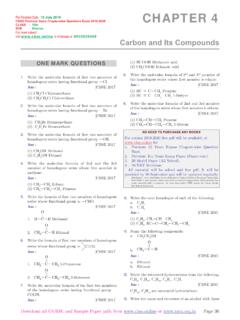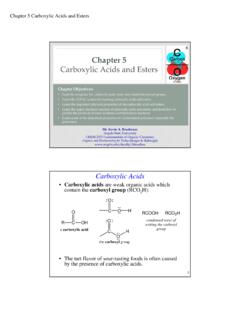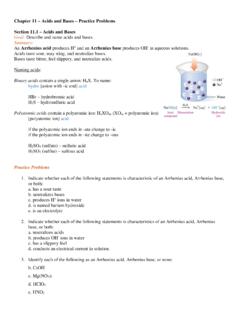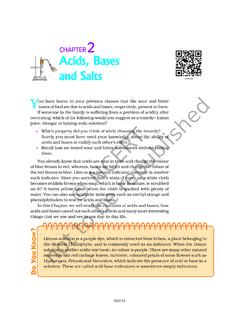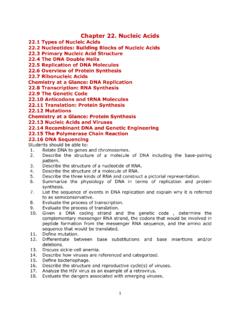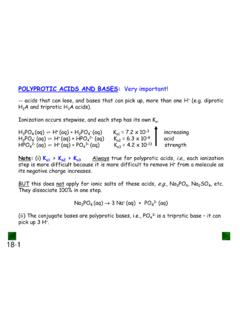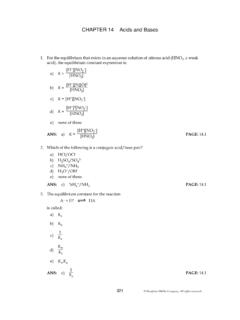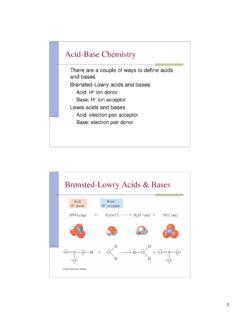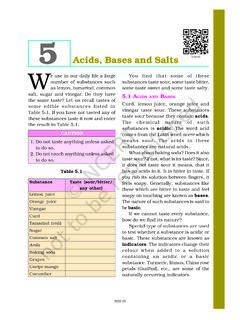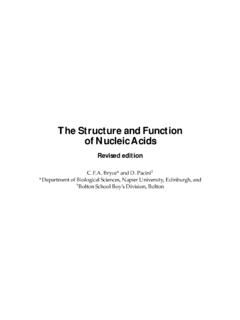Transcription of Bcids, Bases and Salts - VAGA Study
1 Chap 3 aCids, Bases and Salts page 39this pdf is review version of hard book available on amazon. in hard book full explanation are given with Purchase Hard Book of From Amazon Click Here. For More Details Whatsapp at 8905629969 chapter 2 Bcids, Bases and acidsAcids are chemical compounds which have sour taste, consist of hydrogen (H), and turn blue litmus solution red. On the basis of their sources, acids can be classified Organic AcidsThey are derived from living organisms, , plants and animals. For example, tomatoes contain oxalic acid and ants contain formic Mineral AcidsThey are obtained from mineral sources, , sulphuric acid , nitric acid and hydrochloric acid . They are inorganic acids. Many mineral acids find extensive use and Arrhenius Theory of AcidsAccording to this theory, acids are substances that ionise to give H+ ions when dissolved in water, ,()()()HClaqHaqClaq++ Strong AcidsThese acids ionise more or less completely when dissolved in water, , sulphuric acid ()HSO24 nitric acid ()HNO3 and hydrochloric acid (HCl).
2 ()()()HClaqHaqClaq$++ ()()()HSOaqHaqSOaq22442$++ Weak AcidsThese acids ionise to a small extent when dissolved in water, , acetic acid (),CHCOOH3 formic acid (HCOOH) and carbonic acid ()HCO23.()()()aqaqaqCHCOOHCHCOOH23+ +()()HCOHaqCOaq22332++ Reactions of Acids with MetalsDilute acids react with metals to evolve hydrogen.()()().saqgZndilHSOZnSOH2442$++ H2 gas is not evolved when a metal reacts with nitric acid () Reactions of Acids with Metal OxidesMetal oxides, being basic in nature, react with acids to form salt and water.()()()()saqaqlCaOHClCaClHO222$++ Reactions of Acids with Metal Carbonates and Metal Hydrogen carbonatesAcids break up metal carbonates and metal hydrogen carbonates to evolve carbon dioxide gas with brisk effervescence.()()()saqaqNaCOHClNaCl223$ + ()()lgHOCO22++()()()saqaqNaHCOHClNaCl3$+ ()()lgHOCO22++ BasesBases are chemical compounds which have bitter taste, are soapy and slippery to touch, and turn red litmus solution blue, , sodium hydroxide, potassium hydroxide, aluminium hydroxide, etc.
3 Those Bases which are soluble in water are called 40 aCids, Bases and Salts Chap 3To Purchase Hard Book of From Amazon Click Here. For More Details Whatsapp at 8905629969 For Answer and Explanation Question Click the Link in Pink Arrhenius Theory of BasesAccording to this theory, Bases are substances that ionise to give hydroxyl ion ()OH- when dissolved in water, ,()()()NaOHaqNaaqOHaq$++ Strong BasesThey ionise more or less completely on dissolving in water, , NaOH, KOH, ()CaOH2 etc.()()()NaOHaqNaaqOHaq$++ Weak BasesThey ionise to a small extent on dissolving in water, , ammonium hydroxide ()NHOH4, copper hydroxide [()]CuOH2, etc.()()()NHOHaqNHaqOHaq44++ IndicatorsAcid- base indicators (indicators) are natural or synthetic dyes which show a change of colour depending upon the acidity or alkalinity of a indicator like litmus is red in acidic and blue in basic medium.
4 Methyl orange is red in acidic and yellow in basic medium. Phenolphthalein is colourless in acidic and pinkish-red in basic Olfactory Indicators : Those substances whose odour changes in acidic or basic medium are called olfactory indicators, , the smell of onion diminishes in a base but remains as such in an Reactions of Bases with MetalsMetals like Zn and Al react with strong alkalis to evolve H2 gas.()()()()saqaqgZnNaOHNaZnOH2 Sodiumzincate222"++ Reactions of Bases with Non-metallic OxidesBases react with acidic oxides to form salt and water.()()()aqgaqNaOHCONaCO2223$+ ()lHO2+ NeutralisationWhen an acid reacts with a base , it gives salt and water, it is called neutralisation reaction, and also it is an exothermic process.()()()()aqaqaqlHClNaOHNaClHO2"++ pHThe negative exponent of 10 to which it must be raised in order to express the hydrogen ion concentration of the solution in mole per litre.
5 Mathematically, [()]Haq10pH=+ Higher the ()Haq+ concentration, lower is the pH pH ScaleIn neutral solution and pure water, ,pH7= acidic solutions, pH7< and alkaline solutions, pH7>. Universal IndicatorIt is a pH indicator composed of several compounds that exhibit colour changes over a pH value range from 0 to 14. It not only shows acidic or basic nature of solution but also shows approximate pH by giving a particular colour for a specific value of saltsThey are ionic compounds formed by the combination of cation from base and anion from acid .()()()aqaqaqNaOHHClNaCl()()()BaseAc idSalt$+ ()lHO()Water2+ pH of Salt Solutions1. The salt of a strong acid and a weak base gives acidic solution (pH less than 7).()()()slaqNHClHONHOH424+Chap 3 aCids, Bases and Salts page 41this pdf is review version of hard book available on amazon.
6 In hard book full explanation are given with Purchase Hard Book of From Amazon Click Here. For More Details Whatsapp at 8905629969 ()aqHCl+Here, hydrochloric acid (strong acid ) ionises to give ()Haq+ ions which is greater than ammonium hydroxide (weak base ) ionises to give ()OHaq- ions, so, the solution is The salt of a strong base (NaOH) and a weak acid HCO23 gives basic solution (pH more than 7).()()()slaqNHCOHONaOH2232+ ()aqHCO23+ Here, NaOH releases ()OHaq- ion more and HCO23 releases ()Haq+ ion less, so, the solution is The salt of a weak acid (HA) and a weak base (BOH) gives slightly acidic or slightly basic or neutral solution (BA).BAHOHABOH2++ If acid is stronger than base , the solution is acidic ()pH7<. If acid is weaker than the base , the solution is basic ().pH7> If acid and base formed are of equal strength, the solution is neutral ().
7 PH7=4. The salt of a strong acid and a strong base gives neutral solution().pH7= Salts of strong acids and Bases , , NaCl, NaSO24, etc., on dissolving in water do not hydrolyse, so, not disturb the .pH7= Sodium Chloride (NaCI)It is common salt. It is obtained from sea water by the process of of Sodium Chloride1. Sodium chloride (NaCI) helps in proper functioning of the human body, , in muscle contraction, etc. It helps the body to prepare hydrochloric acid in gastric It is used in cooking food and it improves the flavour of It is used to prepare NaOH, NaCO23, Sodium Hydroxide (NaOH)It is prepared on a large scale by electrolysis of a conc. solution of sodium chloride. This solution is called brine.()()()aqlaqNaClHONaOH222 CurrentElectric2+ ()()ggHCl22++Hydrogen gas is obtained at cathode and chlorine gas at anode. NaOH remains in solution. The solution on evaporation gives solid NaOH.
8 This process is called chlor-alkali Sodium Hydroxide is used in manufacturing soaps, detergents, paper, artificial silk (rayon) and dyes. It is used in manufacturing chemicals, , sodium hypochlorite, sodium chlorate, Uses of Hydrogen GasIt is used In manufacturing of ammonia and methyl alcohol and to prepare hydrochloric acid . It is used fur hydrogenating oils to give fats. Vegetable oils on hydrogenation give oil H2"+ Margarine (vegetable ghee) Uses of Chlorine GasIt is used as a bleaching agent in textile industry and used for sterilising Washing Soda ()NaCOHO10232$It is obtained from sodium carbonate ()NaCO23 through ammonia-soda or Solvay process. Its chemical name is sodium carbonate of Washing Soda : It is used for washing clothes and in manufacturing glass, caustic soda, borax, Baking Soda ()NaHCO3It is prepared by passing carbon dioxide through an aqueous solution of sodium carbonate.
9 Its chemical name is sodium hydrogen carbonate or sodium $++It Is a white crystalline solid, sparingly soluble in water and its aqueous solution is mildly alkaline. It decomposes on heating to give NaCO23 and release .CO2 It reacts with acids ()H+ to evolve 42 aCids, Bases and Salts Chap 3To Purchase Hard Book of From Amazon Click Here. For More Details Whatsapp at 8905629969 For Answer and Explanation Question Click the Link in Pink ++NaHCOHNaHOCO322$+++++ Uses of Baking SodaIt is used in cooking and as an antacid to correct the acidity of stomach. It is used in making effervescent drinks and in fire extinguishers, and also in preparing baking Bleaching PowderThe chemical name of bleaching powder is calcium oxychloride ()CaOCl2. It is obtained by passing Cl2 gas over dry slaked lime.()()()()sgsCaOHClCaOClCC2230352+cc ()lHO2+ Uses of Bleaching PowderIt is used for bleaching of wood pulp, cotton, and as a Plaster of ParisIts chemical name is calcium sulphate hemihydrate [(/)]CaSOHO1242$.
10 It is obtained by heating gypsum ()CaSOHO242$.CaSOHOCaSO2lnInakiKK4237339 84$- (/)(/)HOHO123222$+Plaster of Paris on mixing with an adequate quantity of water, it forms a gypsum again.(/)(/)CaSOHOHO1232422$+ CaSOHO242$$ Uses of Plaster of ParisIt is used for immobilising the affected fractured part of bone leading to quick recovery. It is also used for making decorative pieces such as toys, statues, of Paris should be stored in moisture-proof Water of Crystallisation1. Hydrated Salts : A crystalline salt molecule that is loosely attached to a certain number of water molecules is called hydrated salt. These water molecules are water of Hygroscopy : Those substances which absorb moisture from atmosphere at ordinary temperature, are called hygroscopic substances, and the property is known as hygroscopy, , conc. ,HSO24 Deliquescence : Those substances which absorb moisture from atmosphere at ordinary temperature and ultimately dissolve in the absorbed water to form a solution are called deliquescent substances and the phenomenon is called deliquescence, , NaOH, KOH, Efflorescence : Certain hydrated Salts when exposed to air at ordinary temperature lose their water of crystallisation either partially or completely, are called efflorescent Salts and the phenomenon is called efflorescence, , washing soda, epsom salt, etc.








